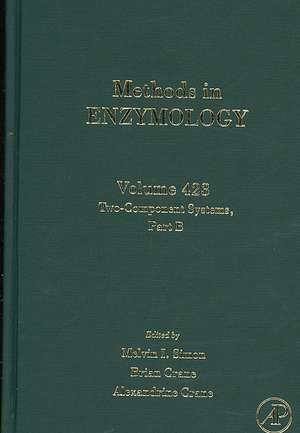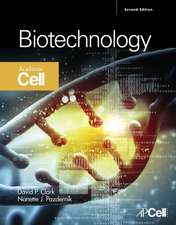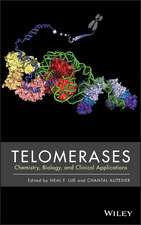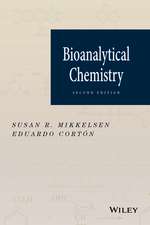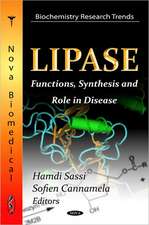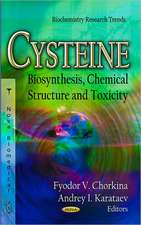Two-Component Signaling Systems, Part B: Methods in Enzymology, cartea 423
Melvin I. Simon, Brian Crane, Alexandrine Craneen Limba Engleză Hardback – 25 iul 2007
Sections in Two-Component Signaling Systems, Part B include:
- Structural Approaches
- Reconstitution of Heterogeneous Systems
- Intracellular Methods and Assays
- Genome-Wide Analyses of Two-Component Systems
- Presents detailed protocols
- Includes troubleshooting tips
Din seria Methods in Enzymology
- 28%
 Preț: 801.23 lei
Preț: 801.23 lei - 32%
 Preț: 802.54 lei
Preț: 802.54 lei - 23%
 Preț: 461.36 lei
Preț: 461.36 lei - 23%
 Preț: 460.60 lei
Preț: 460.60 lei - 23%
 Preț: 439.86 lei
Preț: 439.86 lei - 23%
 Preț: 448.15 lei
Preț: 448.15 lei - 23%
 Preț: 451.42 lei
Preț: 451.42 lei - 23%
 Preț: 445.18 lei
Preț: 445.18 lei - 5%
 Preț: 557.15 lei
Preț: 557.15 lei - 23%
 Preț: 450.67 lei
Preț: 450.67 lei - 23%
 Preț: 446.23 lei
Preț: 446.23 lei - 23%
 Preț: 435.87 lei
Preț: 435.87 lei - 23%
 Preț: 445.94 lei
Preț: 445.94 lei - 23%
 Preț: 459.55 lei
Preț: 459.55 lei - 23%
 Preț: 460.02 lei
Preț: 460.02 lei - 23%
 Preț: 456.61 lei
Preț: 456.61 lei - 23%
 Preț: 450.54 lei
Preț: 450.54 lei - 23%
 Preț: 453.47 lei
Preț: 453.47 lei - 5%
 Preț: 565.37 lei
Preț: 565.37 lei - 23%
 Preț: 450.67 lei
Preț: 450.67 lei - 23%
 Preț: 464.33 lei
Preț: 464.33 lei - 23%
 Preț: 441.49 lei
Preț: 441.49 lei - 23%
 Preț: 447.44 lei
Preț: 447.44 lei - 23%
 Preț: 459.13 lei
Preț: 459.13 lei - 23%
 Preț: 450.38 lei
Preț: 450.38 lei - 23%
 Preț: 445.80 lei
Preț: 445.80 lei - 23%
 Preț: 445.35 lei
Preț: 445.35 lei - 23%
 Preț: 442.53 lei
Preț: 442.53 lei - 23%
 Preț: 450.38 lei
Preț: 450.38 lei - 23%
 Preț: 448.60 lei
Preț: 448.60 lei - 23%
 Preț: 447.57 lei
Preț: 447.57 lei - 23%
 Preț: 458.97 lei
Preț: 458.97 lei - 23%
 Preț: 440.90 lei
Preț: 440.90 lei - 23%
 Preț: 448.15 lei
Preț: 448.15 lei - 23%
 Preț: 466.84 lei
Preț: 466.84 lei - 23%
 Preț: 451.42 lei
Preț: 451.42 lei - 23%
 Preț: 453.64 lei
Preț: 453.64 lei - 23%
 Preț: 459.13 lei
Preț: 459.13 lei - 23%
 Preț: 457.49 lei
Preț: 457.49 lei - 23%
 Preț: 447.44 lei
Preț: 447.44 lei - 5%
 Preț: 561.34 lei
Preț: 561.34 lei - 23%
 Preț: 447.57 lei
Preț: 447.57 lei - 23%
 Preț: 453.35 lei
Preț: 453.35 lei - 23%
 Preț: 441.95 lei
Preț: 441.95 lei - 23%
 Preț: 450.38 lei
Preț: 450.38 lei - 23%
 Preț: 449.19 lei
Preț: 449.19 lei - 23%
 Preț: 456.02 lei
Preț: 456.02 lei - 23%
 Preț: 455.11 lei
Preț: 455.11 lei - 23%
 Preț: 455.87 lei
Preț: 455.87 lei
Preț: 807.24 lei
Preț vechi: 1230.96 lei
-34% Nou
Puncte Express: 1211
Preț estimativ în valută:
154.46€ • 161.27$ • 127.84£
154.46€ • 161.27$ • 127.84£
Carte tipărită la comandă
Livrare economică 28 martie-11 aprilie
Preluare comenzi: 021 569.72.76
Specificații
ISBN-13: 9780123738523
ISBN-10: 0123738520
Pagini: 648
Ilustrații: Illustrated
Dimensiuni: 152 x 229 x 43 mm
Greutate: 1.67 kg
Editura: ELSEVIER SCIENCE
Seria Methods in Enzymology
ISBN-10: 0123738520
Pagini: 648
Ilustrații: Illustrated
Dimensiuni: 152 x 229 x 43 mm
Greutate: 1.67 kg
Editura: ELSEVIER SCIENCE
Seria Methods in Enzymology
Public țintă
Biochemists, geneticists, and molecular biologists.Cuprins
Section I: Structural Approaches
[1]: The PICM Chemical Scanning Method for Identifying Domain–Domain and Protein–Protein Interfaces: Applications to the Core Signaling Complex of E. coli Chemotaxis
[2]: Use of Site-Directed Cysteine and Disulfide Chemistry to Probe Protein Structure and Dynamics: Applications to Soluble and Transmembrane Receptors of Bacterial Chemotaxis
[3]: Measuring Distances by Pulsed Dipolar ESR Spectroscopy: Spin-Labeled Histidine Kinases
[4]: Rigid Body Refinement of Protein Complexes with Long-Range Distance Restraints from Pulsed Dipolar ESR
[5]: TonB/TolA Amino-Terminal Domain Modeling
[6]: Functional Dynamics of Response Regulators Using NMR Relaxation Techniques
[7]: The Design and Development of Tar-EnvZ Chimeric Receptors
[8]: Functional and Structural Characterization of EnvZ, an Osmosensing Histidine Kinase of E. coli
[9]: Light Modulation of Histidine-Kinase Activity in Bacterial Phytochromes Monitored by Size Exclusion Chromatography, Crosslinking, and Limited Proteolysis
[10]: A Temperature-Sensing Histidine Kinase—Function, Genetics, and Membrane Topology
[11]: The Regulation of Histidine Sensor Kinase Complexes by Quorum Sensing Signal Molecules
Section II: Reconstitution of Heterogeneous Systems
[12]: Liposome-Mediated Assembly of Receptor Signaling Complexes
[13]: Analyzing Transmembrane Chemoreceptors Using In Vivo Disulfide Formation Between Introduced Cysteines
[14]: Using Nanodiscs to Create Water-Soluble Transmembrane Chemoreceptors Inserted in Lipid Bilayers
[15]: Assays for CheC, FliY, and CheX as Representatives of Response Regulator Phosphatases
[16]: Genetic Dissection of Signaling Through the Rcs Phosphorelay
Section III: Intracellular Methods and Assays
[17]: In Vivo Measurement by FRET of Pathway Activity in Bacterial Chemotaxis
[18]: In Vivo and In Vitro Analysis of the Rhodobacter sphaeroides Chemotaxis Signaling Complexes
[19]: In Vivo Crosslinking Methods for Analyzing the Assembly and Architecture of Chemoreceptor Arrays
[20]: A “Bucket of Light for Viewing Bacterial Colonies in Soft Agar
[21]: Phenotypic Suppression Methods for Analyzing Intra- and Inter-Molecular Signaling Interactions of Chemoreceptors
[22]: Single-Cell Analysis of Gene Expression by Fluorescence Microscopy
Section IV: Genome-Wide Analyses of Two-Component Systems
[23]: Two-Component Systems of Mycobacterium tuberculosis—Structure-Based Approaches
[24]: Transcriptomic Analysis of ArlRS Two-Component Signaling Regulon, a Global Regulator, in Staphylococcus aureus
[25]: Global Analysis of Two-Component Gene Regulation in H. pylori by Mutation Analysis and Transcriptional Profiling
[26]: Phosphotransfer Profiling: Systematic Mapping of Two-Component Signal Transduction Pathways and Phosphorelays
[27]: Identification of Histidine Phosphorylations in Proteins Using Mass Spectrometry and Affinity-Based Techniques
Subject Index
Author Index
[1]: The PICM Chemical Scanning Method for Identifying Domain–Domain and Protein–Protein Interfaces: Applications to the Core Signaling Complex of E. coli Chemotaxis
[2]: Use of Site-Directed Cysteine and Disulfide Chemistry to Probe Protein Structure and Dynamics: Applications to Soluble and Transmembrane Receptors of Bacterial Chemotaxis
[3]: Measuring Distances by Pulsed Dipolar ESR Spectroscopy: Spin-Labeled Histidine Kinases
[4]: Rigid Body Refinement of Protein Complexes with Long-Range Distance Restraints from Pulsed Dipolar ESR
[5]: TonB/TolA Amino-Terminal Domain Modeling
[6]: Functional Dynamics of Response Regulators Using NMR Relaxation Techniques
[7]: The Design and Development of Tar-EnvZ Chimeric Receptors
[8]: Functional and Structural Characterization of EnvZ, an Osmosensing Histidine Kinase of E. coli
[9]: Light Modulation of Histidine-Kinase Activity in Bacterial Phytochromes Monitored by Size Exclusion Chromatography, Crosslinking, and Limited Proteolysis
[10]: A Temperature-Sensing Histidine Kinase—Function, Genetics, and Membrane Topology
[11]: The Regulation of Histidine Sensor Kinase Complexes by Quorum Sensing Signal Molecules
Section II: Reconstitution of Heterogeneous Systems
[12]: Liposome-Mediated Assembly of Receptor Signaling Complexes
[13]: Analyzing Transmembrane Chemoreceptors Using In Vivo Disulfide Formation Between Introduced Cysteines
[14]: Using Nanodiscs to Create Water-Soluble Transmembrane Chemoreceptors Inserted in Lipid Bilayers
[15]: Assays for CheC, FliY, and CheX as Representatives of Response Regulator Phosphatases
[16]: Genetic Dissection of Signaling Through the Rcs Phosphorelay
Section III: Intracellular Methods and Assays
[17]: In Vivo Measurement by FRET of Pathway Activity in Bacterial Chemotaxis
[18]: In Vivo and In Vitro Analysis of the Rhodobacter sphaeroides Chemotaxis Signaling Complexes
[19]: In Vivo Crosslinking Methods for Analyzing the Assembly and Architecture of Chemoreceptor Arrays
[20]: A “Bucket of Light for Viewing Bacterial Colonies in Soft Agar
[21]: Phenotypic Suppression Methods for Analyzing Intra- and Inter-Molecular Signaling Interactions of Chemoreceptors
[22]: Single-Cell Analysis of Gene Expression by Fluorescence Microscopy
Section IV: Genome-Wide Analyses of Two-Component Systems
[23]: Two-Component Systems of Mycobacterium tuberculosis—Structure-Based Approaches
[24]: Transcriptomic Analysis of ArlRS Two-Component Signaling Regulon, a Global Regulator, in Staphylococcus aureus
[25]: Global Analysis of Two-Component Gene Regulation in H. pylori by Mutation Analysis and Transcriptional Profiling
[26]: Phosphotransfer Profiling: Systematic Mapping of Two-Component Signal Transduction Pathways and Phosphorelays
[27]: Identification of Histidine Phosphorylations in Proteins Using Mass Spectrometry and Affinity-Based Techniques
Subject Index
Author Index
